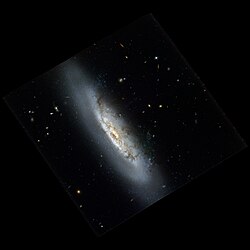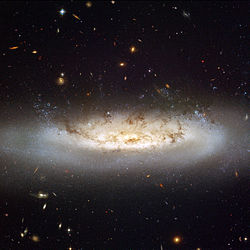| NGC 4522 | |
|---|---|
 Hubble Space Telescope image of NGC 4522. | |
| Observation data (J2000 epoch) | |
| Constellation | Virgo |
| Right ascension | 12h 33m 39.7s [1] |
| Declination | 09° 10′ 30″ [1] |
| Redshift | 0.007769 [1] |
| Heliocentric radial velocity | 2329 km/s [1] |
| Distance | 56.4 Mly [2] |
| Group or cluster | Virgo Cluster |
| Apparent magnitude (V) | 13.0 [1] |
| Characteristics | |
| Type | SB(s)cd [1] |
| Size | ~68,850 ly (estimated) [1] |
| Apparent size (V) | 3.95 x 0.84 [1] |
| Other designations | |
| CGCG 70-168, IRAS 12311+0926, MCG 2-32-137, PGC 41729, UGC 7711, VCC 1516 [1] | |
NGC 4522 is an edge-on spiral galaxy located about 60 million light-years away within the Virgo Cluster [3] in the constellation Virgo. [4] NGC 4522 is losing its molecular gas though ram-pressure stripping as it plows though the cluster at a speed of more than 10 million kilometres per hour. [5] The galaxy was discovered by astronomer John Herschel on January 18, 1828. [6]

